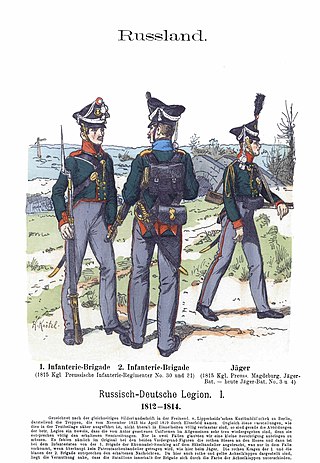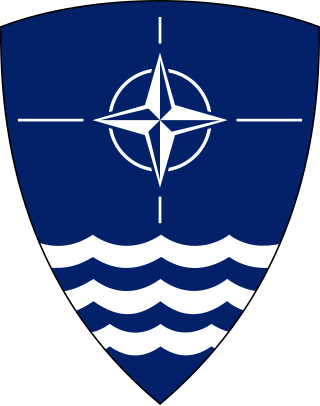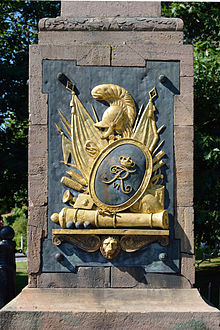
The King's German Legion was a British Army unit of mostly expatriated German personnel during the period 1803–16. The legion achieved the distinction of being the only German force to fight without interruption against the French during the Napoleonic Wars.

General Baron Hugh Halkett, GCH, CB, was a British soldier during the Napoleonic Wars and later a general of infantry in the Hanoverian service.

The Battle of Teugen-Hausen or the Battle of Thann was an engagement that occurred during the War of the Fifth Coalition, part of the Napoleonic Wars. The battle was fought on 19 April 1809 between the French III Corps led by Marshal Louis-Nicolas Davout and the Austrian III Armeekorps commanded by Prince Friedrich Franz Xaver of Hohenzollern-Hechingen. When the Austrians withdrew that evening, the French won a hard-fought victory over their opponents. The site of the battle is a wooded height approximately halfway between the villages of Teugn and Hausen in Lower Bavaria, part of modern-day Germany.

The city of Hamburg was one of the most powerful fortresses east of the Rhine. After being freed from Napoleonic rule by advancing Cossacks and other following Coalition troops it was once more occupied by Marshal Davout's French XIII Corps on 28 May 1813, at the height of the German Campaign during the War of the Sixth Coalition from French rule and occupation. Ordered to hold the city at all costs, Davout launched a characteristically energetic campaign against a similar numbered Army of the North made up of Prussian and other Coalition troops under the command of Count von Wallmoden-Gimborn, winning a number of minor engagements. Neither force was decidedly superior and the war ground to a halt and resulted in a rather stable front line between Lübeck and Lauenburg and further south along the Elbe river, even after the end of the cease-fire of the summer 1813. In October 1813 a French column's movement towards Dannenberg resulted in the only major engagement in Northern Germany, the Battle of the Göhrde. The defeated French troops retreated back to Hamburg.
This is an order of battle of the French and German Armies at the beginning of the Franco-Prussian War in 1870.

Sehestedt is a municipality in the district of Rendsburg-Eckernförde, in Schleswig-Holstein, Germany.
The Battle of the Göhrde took place during the War of the Sixth Coalition on 16 September 1813 between French and Coalition troops at Göhrde, Germany. The French troops were defeated and withdrew to Hamburg.

The Schleswig Regiment of Foot is a Royal Danish Army infantry regiment. On 1 January 2001, the regiment was merged with the Queen's Life Regiment to form the Prince's Life Regiment. In 2018, it was announced that the regiment would be reestablished on 1 January 2019 as a light infantry battalion.

The Russian–German Legion was a military unit set up in 1812 by the banished Graf Peter of Oldenburg on the instigation of Tsar Alexander I of Russia.

The Battle of Bornhöved or Bornhöft took place on 7 December 1813 between a Swedish cavalry regiment under Bror Cederström and Prince Frederik of Hesse's Danish troops reinforced by smaller numbers of Polish cavalry and German infantry. The clash occurred at the small village of Bornhöft in what is now Schleswig-Holstein in northern Germany. The engagement occurred during the War of the Sixth Coalition, part of the Napoleonic Wars, and was the last time Swedish and Danish forces met on the battlefield.

Prince Frederik of Hesse, Landgrave Friedrich of Hesse-Cassel was a Danish-German nobleman, field marshal and governor-general of Norway (1810–1813) and the same in the duchies of Schleswig and Holstein (1836–1842).
The Battle of Køge was a battle on 29 August 1807 between British troops besieging Copenhagen and Danish militia raised on Sjælland. It ended in British victory and is also known as 'Træskoslaget' or 'the Clogs Battle', since many of the Danish militiamen threw their heavy wooden clogs away when they were fleeing.

Allied Forces Baltic Approaches (BALTAP) was a Principal Subordinate Command (PSC) of the NATO Military Command Structure, with responsibility for the Baltic Sea area. It was in existence from 1962 to 2002 and consisted of the Danish Armed Forces, units of the West German Bundeswehr and allied wartime reinforcements.

In the Battle of Halle on 17 October 1806 a French corps led by Jean-Baptiste Bernadotte fought the Prussian Reserve under Eugene Frederick Henry, Duke of Württemberg. The French defeated their opponents, forcing the Prussians to retreat northeast toward Dessau after suffering heavy losses. The clash occurred in the War of the Fourth Coalition, part of the Napoleonic Wars. The city of Halle is located about 30 kilometers northwest of Leipzig on the Saale River.

The Battle of Czarnowo on the night of 23–24 December 1806 saw troops of the First French Empire under the eye of Emperor Napoleon I launch an evening assault crossing of the Wkra River against Lieutenant General Alexander Ivanovich Ostermann-Tolstoy's defending Russian Empire forces. The attackers, part of Marshal Louis-Nicolas Davout's III Corps, succeeded in crossing the Wkra at its mouth and pressed eastward to the village of Czarnowo. After an all-night struggle, the Russian commander withdrew his troops to the east, ending this War of the Fourth Coalition action. Czarnowo is located on the north bank of the Narew River 33 kilometres (21 mi) north-northwest of Warsaw, Poland.
The VIII Corps of the Grande Armée was a French military unit that existed during the Napoleonic Wars. Emperor Napoleon I formed it in 1805 by borrowing divisions from other corps and assigned it to Marshal Édouard Mortier. Marshal André Masséna's Army of Italy was also reorganized as the VIII Corps at the end of the 1805 campaign. The corps was reformed for the 1806 campaign under Mortier and spent the rest of the year mopping up Prussian garrisons in western Germany.
The XIII Corps of the Grande Armée was a French military unit that existed during the Napoleonic Wars. The corps was formed in the spring of 1813 and Marshal Louis-Nicolas Davout was appointed as its commander. The corps included three French infantry divisions and attached cavalry. During the German campaign, the XIII Corps was assigned to defend northern Germany. Accordingly, Davout seized Hamburg and prepared to defend it against the Allies. In September 1813, one brigade was defeated at the Battle of the Göhrde. After Emperor Napoleon I's decisive defeat at the Battle of Leipzig in October, the XIII Corps became isolated in Hamburg. An Allied army under Russian General Count von Bennigsen initiated the Siege of Hamburg in December.
Georg Wilhelm Baron von dem Bussche-Haddenhausen was a general officer of Hanoverian soldiers during the War of the First Coalition who famously led one of the Coalition columns at the Battle of Tourcoing. In 1743 he joined the Hanoverian military service and fought in the War of the Austrian Succession and Seven Years' War, fighting at Minden and Lutterberg. He led a battalion at Gibraltar in the American Revolutionary War. In the War of the First Coalition he led his soldiers at Valenciennes, Hondschoote, Mouscron, Tourcoing and Tournai. On 11 December 1794 while defending the Bommelerwaard in the Dutch Republic, his hand was taken off by a cannonball and he died shortly afterward.

The Skirmish of Oversø near Flensburg was a German victory of the Danish forces in the struggle for Schleswig-Holstein. The Germans forces included contingents from the Kingdom of Hanover and Duchy of Mecklenburg.

The Battle of Vejle was a battle of the Second Schleswig War that occurred on March 8, 1864, between the Austrian Empire and Denmark on the town of Vejle. The Austrian victory at the battle opened the way for the Evacuation of Fredericia and the Battle of Jasmund as well as solidifying Ludwig von Gablenz's military career.

















